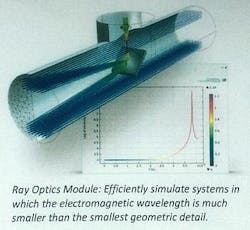COMSOL prereleases version 5.0 of its Multiphysics software; unveils ray optics, 'Application Builder' for industry
On October 8, 2014, COMSOL (Burlington, MA) announced the prerelease of the newest version of the company's Multiphysics software, version 5.0, at the COMSOL Conference 2014 Boston. The company's developers are finishing up the details of the new release; the final version will be ready within weeks.
For those not familiar with the COMSOL Multiphysics software, it is a suite that can numerically model many different types of physical processes, including thermal, mechanical, electromagnetic, electrical chemical, fluid flow, and so on. Such processes can be modeled separately or in combination with the use of different "modules." The software is intended for use by scientists, engineers, and other specialists (such as manufacturing and reliability).
The software has been used to model everything from photonic components to rockets, biomedical instruments, and subduction of the Earth's crust. Photonics capabilities have included modeling of electromagnetic, wave optics, thermal, mechanical strain, and other processes.
New tools for photonics
For people in optics and photonics, Version 5.0 includes a new Ray Optics Module for analyzing systems in which the electromagnetic wavelength is much smaller than the smallest detail in the model. This module has capabilities that include modeling partially coherent light, as well as various polarization states, according to Christopher Boucher, a COMSOL developer of the module.
"The Ray Optics Module is not like any other simulation software available for modeling ray optics," says COMSOL software developer Dan Smith. "For the first time, multiphysics simulations can now be integrated into the modeling of geometrical optics, a truly cutting-edge development for the simulation industry."
Smith notes that the addition of the ray-tracing capability to the existing wave-optics and radio-frequency modeling abilities extends the use of COMSOL optics modeling across the electromagnetic spectrum to very short wavelengths -- even x-rays. The one caveat for the Ray Optics Module is that the geometry of the model details remain much larger than the wavelength (which tends to be easier to satisfy as the wavelength gets shorter).
These ray-tracing calculations can be combined with those from other modules to model, for example, thermal expansion, fluid flow, and so on.
Another, more general tool was introduced by COMSOL at the Boston conference: the Application Builder, which allows engineers to turn a COMSOL Multiphysics model into a separate custom application that hides most of the complexity (as far as tweaking parameters etc.) of the model itself and is instead streamlined for use, for example, by a test engineer or even someone on a production line. The resulting application includes only the parameters relevant to the design of a specific device (or product).
There are two ways to run such a custom app: 1) via a Windows client program that enables the app; or 2) on a web browser, which relies on COMSOL servers and allows running the app on tablets and smartphones (it is faster, however, to use the native Windows program).
"The Application Builder is our vision for the future of simulation," says Svante Littmarck, CEO and president of COMSOL. "It brings the expertise of engineering specialists working in research and development to a greater majority of people, revolutionizing the product-design process by allowing the power of multiphysics simulation to drive productivity and innovation. This is achieved by supplying those involved in the design and manufacturing process across all engineering disciplines with apps created by simulation experts."
Source: COMSOL (www.comsol.com)

John Wallace | Senior Technical Editor (1998-2022)
John Wallace was with Laser Focus World for nearly 25 years, retiring in late June 2022. He obtained a bachelor's degree in mechanical engineering and physics at Rutgers University and a master's in optical engineering at the University of Rochester. Before becoming an editor, John worked as an engineer at RCA, Exxon, Eastman Kodak, and GCA Corporation.
